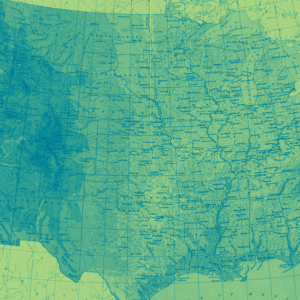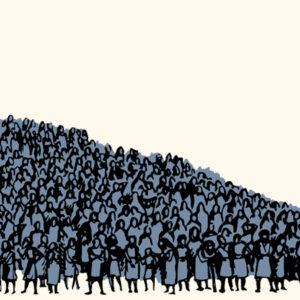
What is the Millennial Midlife Crisis Novel?
Brittany Allen on Drifting Women, Aphoristic Prose, and Women on the Edge
Writing The Cut this past May, Amil Niazi diagnosed the Millennial midlife crisis. “For most millennials, the old material markers of mid-life, like owning a home or spending 20-plus years at one job, are a nostalgic fantasy. Something we miss but never had,” she wrote. She goes on to acknowledge the usual sticky wickets. We Millennials are worried about lifelong debt, compounded by unfavorable winds in the gig economy and a threadbare social safety net. Physically, we face climate catastrophe, and the rise of fascism. Spiritually, we flail about in quiet, Internet-exacerbated, always-be-optimizing desperation. That is, these are your midlife concerns if you’re a very, very lucky American.
To the extent that generation trend-casting is at all scientific (and I’ll show my cards—this jury is out), I agree with the bones of her categorization. These concerns describe my midlife, anyway. But then I got to thinking. How is this crisis showing up in our literature?
*
In a sharp essay in her new collection, All Things Are Too Small, the critic Becca Rothfeld identifies a trend she calls the “minimalist” novel. This kind of novel, she claims, is delivered in aphoristic fragments, and “a spare and serviceable mode, sort of IKEA-prose.” It may feel plotless and drift-y, like Kate Zambreno’s Drifts. And it typically follows a cis, white, straight-ish woman through an intellectual or spiritual dilemma kicked off by a logistical one (such as a bedbug infestation).
These novels—whose platonic ideal we might locate from a generation earlier (X), in Jenny Offill’s bug-bedeviled Dept. of Speculation (2014), or Rachel Cusk’s Outline (2014)—feature a woman whose finances are precarious, though she is technically a member of the PMC. She is an artist herself, though may feel creatively unfulfilled. And if she is not a(n ambivalent) mother, she is ambivalently contemplating motherhood. This woman is in her thirties to mid-forties. And so de facto, her most recent incarnation is… a Millennial.
Though I wrestled with parts of Rothfeld’s piece (I resent how often Offill’s lovely, weird books have been made into rhetorical lightning rods, stand-ins for autofiction-as-world-ending-phenomenon) it struck me that the novels she shelves by form could just as easily be lumped by content. Yet defining the Millennial midlife crisis novel as interchangeably “minimalist” feels imprecise.
Another dismissive review of one of Those Books from a major paper manages that lumping, while reading a prototypical narrator for filth. Here’s a category for you: “Plotless treadmill diary of a 30-something artist-class white Brooklynite who was born into what she unrealistically thought was a safer, more forgiving world.” Is this way harsh, Tai? Yes. But this language can describe a canon. The sense and sensibility of thirty and fortysomethings, on the edge.
*
Per the Pew Research Center, “Anyone born between 1981 and 1996 [ages 28 to 48 in 2024] is considered a Millennial.” “Midlife” is harder to categorize. Cultural consensus has toggled, pinning its start point variously at age 35 (when pregnancy, at least, becomes “geriatric”) or “sometime in one’s mid-40s.” Lately, researchers have been unstitching the markers of midlife from chronological age. In a 2022 piece for The Washington Post, Soomi Lee classified this era as a “time when individuals occupy the greatest number of social roles.” These roles might include “paid worker or homemaker; spouse or partner; parent; and adult child.”
Millennials in midlife may have especially weak support for these social roles. We certainly face a bleaker job market than our Gen X antecedents. This may account for the predominance of fickle employment in our fiction. The midlife crises articulated in Christine Smallwood’s A Life of the Mind (2021) and Lynn Steger Strong’s Want (2020) are exacerbated by unstable adjunct wages. In a summary review of both these books for The Nation, Maggie Doherty observed how precarious circumstances dictate structure. “In both novels, plot—the literary structure that signals progress—gives way to an atmosphere of anxious uncertainty,” she wrote, “one familiar to many of us who came of age during a moment of financial and ecological crisis.”
Midlife Millennials also seem to be questioning the topos of monogamous partnership in a world where jointly filed tax returns rarely grant a break. Relatedly, a lot of fiction explores the brutality of parenting without a social safety net. We meet the protagonists in Claire Vaye Watkins’s I Love You But I’ve Chosen Darkness (2021) and Lydia Kiesling’s The Golden State (2018) on the tips of sleep-deprived breakdowns, precipitated in part by new parenthood.
These novels are wetter and more stylish than certain of their “IKEA prose” peers (and so to this reader, more exciting) but they also traffic in drift. Disenchanted by the chains of the nuclear family (or in Kiesling’s book, the bureaucracy that can strain it), these heroes wander in search of something beyond the grind. Daphne, the frantic new mother in The Golden State, perceives the world unraveling before making a break for the desert. “It does feel like the concentric structures that described social life in Altavista have expanded wider and wider until their essential structure has stretched and broken apart,” she laments.
Here I pause to observe the collapse of certain categorizations. What makes Rothfeld’s “minimalism” feel so close in kind to what Waldman has called “mom-lit?” Or what Doherty has dubbed “adjunct lit? Or what hundreds have called “autofiction?” This line of inquiry points us back to the real middle of the diagram here: the unbearable whiteness of being. Yet it can’t be true that the only Millennials having midlife crises are white, straight-ish, heavily educated women. So why do their voices seem loudest on this subject, and in this mode?
*
There are some obvious factors to blame, which I’ll try not to belabor. But first it’s worth pausing to pull out a working definition of the “midlife crisis.”
In a grim op-ed on the subject last March for The New York Times, Jessica Grose wrote:
The traditional midlife crisis, as presented in popular culture, at least, unfolds amid suburban ennui. Disaffected adults feel trapped by conformity and the circumstances of marriage, children and a well-appointed house with a lawn that needs mowing every Saturday. Everybody smokes cigarettes (or these days, picks up a vape) and has affairs. The men buy sports cars and get hair plugs.
If you buy this categorization, it follows that the crisis is a necessarily classed experience. Its first fictive iterations conjure Cheever characters, gazing hard at their navels or into glasses of scotch. (Because heavy is the head that wins the bread!) In this light, it’s plausible the crisis is subject-bound. Perhaps because middle class, heteronormative arrangements breed a specific kind of despair.
In a recent episode of their delightful podcast “Critics at Large,” New Yorker writers Alexandra Schwartz, Vinson Cunningham, and Naomi Fry pushed on that assumption. Their conversation hinged on a review of (Gen X author) Miranda July’s new novel, All Fours, but wandered into wider vistas. Dismissing some OG features of the crisis plot (“the Porsche-ness of it all, the menopause, the affairs…”) Fry observed that the predicament is, at its core, always the fruit of choice. “Not only am I allowed to be dissatisfied,” she said, describing All Fours’ protagonist. “I’m allowed to do something about it.”
Feeling permission “to do something” could account, on the one hand, for the prevalence of certain narrators here. Thanks to feminism, (middle class, white) women finally feel allowed to express dissatisfaction, let alone demand better organizing conditions. This is sort of exciting, but speaks to skinny gains. Because—bracketing the troubling fact that so many middle class white women seem to be in crisis, it follows that the rest of us experiencing existential dissatisfaction are generally disinclined to gripe about it. At least not via an interior, drifty novel, with a narrator of a certain age.
In her 2020 novel, Transcendent Kingdom, the squarely Millennial novelist Yaa Gyasi follows Gifty, a scientist, from childhood to the cusp of midlife. But her crisis is really someone else’s. Gifty is a caretaker for a clinically depressed mother. We meet her as her life is telescoping around the social roles of work as Ph.D. candidate, and parenting a parent with chronic illness.
The novel’s plot has a pleasingly aimless, reflective engine, like some of its genre cousins. But some reviews dwelled on Gifty’s narrative remove. There are places where our hero seems alienated from her own desires, or at least disinclined to explore them. But following Fry’s thought, this may be because she doesn’t feel permission to articulate dissatisfaction. The book makes this case, in fact, via Gifty’s frequent ruminating on the burden of duty, and by alluding often to the troubled communication infrastructure she’s inherited from her parents. There is also, guiding her crisis, the “throbbing stone of self-hate” she carries everywhere.
There is also the fact that a loved one’s health crisis is a uniquely consuming event. Consider the back half of another debatable canon entry—Patricia Lockwood’s No One is Talking About This (2021). In this novel, the prose meaningfully shifts between part one (an eloquent, interior spiral into disintegration, told in aphorism) and part two (in which our narrator witnesses the end of her niece’s life.) Most reviews seemed to dwell on this book’s attempt to describe the gestalt of the internet, but I found the novel brilliant because it captures two kinds of crisis: one interior, one external. It also acknowledges how the texture of unraveling changes in context. Because the woman weighing her own choices against her own mortality is one thing. The woman discovering someone else’s mortality is another entire.
Anyway, however it’s happening—and per Grose’s larger argument, Niazi’s complaint, and my own human eyes—many Millennials are in crisis, one way or another. And whether our stressors are “existential” or “material… economic, familial and political,” they are evidently ripe for drama. But do things get too slippery when we let the world in? Is it still a “midlife crisis” if it’s happening outside your head?
*
On “Critics at Large,” Cunningham teased the possibility of a new relationship to this whole ennui-chilada. “The midlife crisis only works if there is a great cliff of adulthood from which to fall,” he said. “If all of us are trying to elongate our childhoods, trying to be young for longer than we ought perhaps, or than we used to… it’s a stranger fall. It’s a weirder trajectory, to then have a problem with where you landed.”
Perhaps because I’m slouching into midlife myself, I’ll admit that I’ve gotten pleasure from many of the titles Rothfeld categorizes in her essay. I loved Dept. of Speculation, and plenty of the work it permitted. And I return to the exploding parents in Kiesling’s and Watkins’ and Strong’s pages and feel affirmed by the insistence of self in the face of obligation, or disappointment. In their various ways, many of today’s midlife narrators grant us permission to do something about desperate conditions. Whether that means running away, rebelling, or merely finding ways to laugh at them.
And while some critics of the “plotless treadmill diary” roll their eyes at the aimless structure, to decry a grinding plot on this subject seems to miss a point. Because you know what’s grinding? A crisis.
At the same time, I am curious about novels that engage this peculiar life moment via different modes, unbound from the aesthetics it’s commonly dressed in. How might the crisis look different, for instance, if the narrator does not confess to a reader in first person? What if the prose is not IKEA-spare, or hyper-erudite? Can this kind of novel bear a tighter plot?
And as for our subjects? Though I remain cynically unconvinced that this entry-point can be entirely de-classed or de-gendered or de-raced (should it be, is another question), I’m stuck on the idea of the stranger trajectory. What does the fall from adulthood look like if we trace it from different heights?
And for those of us who may never have expected the “safer, more forgiving world” where does the end of youth point? Up, maybe.
Brittany Allen
Brittany K. Allen is a writer and actor living in Brooklyn.












